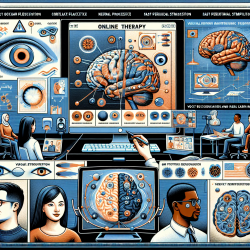Introduction
In the field of speech-language pathology, understanding the genetic and environmental interactions that influence neurodevelopmental outcomes is crucial. The recent study titled "A Set-Based Mixed Effect Model for Gene-Environment Interaction and Its Application to Neuroimaging Phenotypes" provides valuable insights into how these interactions can be modeled and analyzed using advanced statistical techniques. This blog post aims to explore how practitioners can leverage these findings to enhance their practice and encourage further research in this domain.
Understanding the MixGE Model
The study introduces a set-based mixed effect model for gene-environment interaction (MixGE) applied to neuroimaging phenotypes. This model incorporates both fixed and random effects of gene-environment interactions (G×E), allowing for a comprehensive investigation of how genetic variants and environmental factors collectively influence brain phenotypes. The MixGE model is particularly advantageous as it avoids the computationally expensive parameter estimation process, thereby increasing statistical power and efficiency.
Key Findings and Implications
One of the significant findings of the study is the identification of a potential interaction effect between the gene ABCA7 and cardiovascular risk factors on local volume changes in the right superior parietal cortex. This discovery highlights the importance of considering both genetic predispositions and environmental influences in understanding neurodevelopmental outcomes.
For practitioners, these findings underscore the necessity of adopting a holistic approach when assessing and treating children with neurodevelopmental disorders. By considering both genetic and environmental factors, practitioners can develop more targeted and effective intervention strategies.
Practical Applications for Practitioners
- Enhanced Assessment: Incorporating genetic information into assessments can provide a more comprehensive understanding of a child's developmental profile.
- Targeted Interventions: By identifying specific gene-environment interactions, practitioners can tailor interventions to address the unique needs of each child.
- Collaborative Research: Engaging in collaborative research with geneticists and neuroscientists can lead to the development of innovative therapeutic approaches.
Encouraging Further Research
While the MixGE model offers a robust framework for analyzing gene-environment interactions, there is still much to explore in this field. Practitioners are encouraged to engage in research that further investigates the complex interplay between genetics and environment in neurodevelopmental disorders. Such research can lead to the identification of new biomarkers and therapeutic targets, ultimately improving outcomes for children.
Conclusion
The integration of genetic and environmental data through models like MixGE represents a significant advancement in understanding neurodevelopmental disorders. By leveraging these insights, practitioners can enhance their practice and contribute to the growing body of research in this field. To read the original research paper, please follow this link: A Set-Based Mixed Effect Model for Gene-Environment Interaction and Its Application to Neuroimaging Phenotypes.










